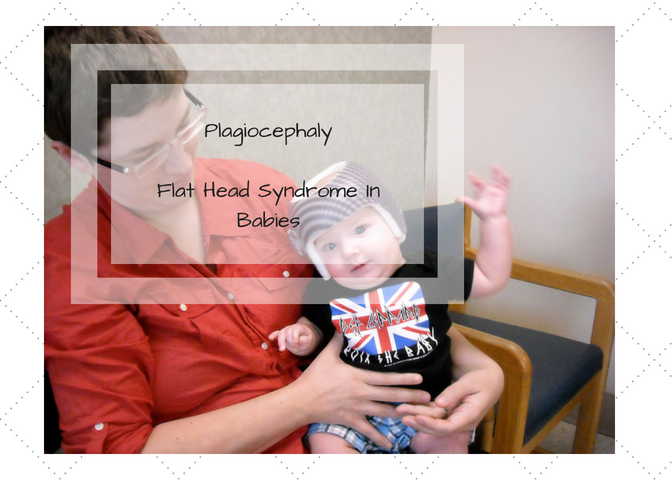If you see your friend’s child wearing a helmet and wonder what is this? The helmet is nothing but the treatment for Plagiocephaly also known as flat head syndrome. First time when I saw any kid wearing such a helmet was when one of my friend’s came to my place with her baby girl who was wearing one.
When you hear this word from your baby’s pediatrician, it sounds scary. It’s natural. Questions start to swim around in our heads what this term means or what should we ask our pediatrician. Once you digest the news, now you want to know more about it and prepare yourself.
Plagiocephaly is relatively a new diagnosis. In simple terms, this scary sounding word also means Flat Head Syndrome. Plagiocephaly is a condition characterized by changes in skull shape and symmetry. Some infants may have noticeable skull shape deformity at birth that resolves itself in the early postnatal period. Positional Plagiocephaly refers specifically to infants with changes in skull shape, who are older than six weeks of age.
It is also known as flat head and is usually caused by pressure on one part of the head, causing it to flatten. This can happen prenatally due to the position of the baby in the uterus or postnatally due to the fact that babies have very soft skull bones.
For better understanding, let’s divide the post into parts:
How do I know my baby has Plagiocephaly?
Usually, the pediatrician makes the initial diagnosis. In its initial stages, it is hard to detect it at home. Your child’s pediatrician explains to you the meaning of this term, type, treatment plan and other details. It is helpful to follow-up with the doctor once you know your child has flat head syndrome.
When to talk to our doctor about Plagiocephaly?
For first time parents, it is very hard to know the time when you have to discuss it with your child’s pediatrician.
- Monitor your baby’s head: Best way to analyze the shape of your baby’s head is to see it from the top. Ask your spouse to hold the baby. Babies experiencing flat head syndrome may have a head shape that appears flat on one side, wide towards the back, or long and thinner than normal.
- Baby’s Ear Alignment: Another telltale sign of flat head syndrome is the misalignment of the ears. If you place baby in your lap and place your fingers at the same spot on each ear you can look to see if your fingers are aligned. If you want to draw an imaginary line then will it end at the exact point on the other side? If no then make an appointment.
- Facial Symmetry: This might be slightly tough for you to judge as you see your baby every-day. If you are unsure about your observation, make an appointment.
What can be done at home?
- Tummy time: Spending too much time lying on their backs can lead to plagiocephaly or flat head syndrome. Tummy time can help to some extent in this case.
- While playing: while you are playing with your baby, try to engage him/her to the other side. He will not willingly look to the other side as it’s not his favorite side but try to keep the toys on the other side.
- Nap-time pillows: New-borns spend most of their time sleeping. If your baby is developing flat-head then s(he) might prefer sleeping on his/her favorite side which increases the chances of plagiocephaly. There are some pillows which are easily fit on top of the crib mattress. It has a mesh insert where the baby rests and therefore does not put any pressure on a single spot of the baby’s head. Few other pillows are in Moon shape which can also be used as a neck support in the car seat or stroller for your older baby or toddler.
- Crib placement: Sometimes, babies want to look to their left well because you have decorated it with stickers, photographs. Positioning baby the same way in a cot will result in baby naturally following the light and turning their head to the same side all the timeTry moving around the crib to a different wall (right in this case) and place those things there. See if the baby starts looking to the right side.
If nothing is working out then Helmet is another option:
This is a custom-made helmet which is designed for your baby’s head. After taking the measurements, the cranial specialist will order a custom-made helmet for your baby. The tough part is your baby is supposed to wear it for almost 22-23 hours. You can take it off when giving a bath. But it’s for your baby’s good. Once your baby starts wearing the helmet, according to the improvement in head shape, the specialist will make the adjustments to make room for your baby’s head to fit comfortably in the helmet.
Message to the parents:
Pat your back. Your baby has graduated!! Your baby may get a lot of attention with a helmet on, and most of it will be good. Some might think it’s for his head safety. So, handle those question with a smile. Not everyone is aware of plagiocephaly? Were you aware of this term before? You will become a stronger, more aware parent during the process
Just think, when it is over, it is a great feeling to know you did this for your baby.Babies heads develop so much in the first 12 months of life. It really is essential to try to correct the problem during this very important stage of growth
If you’re on your own helmet journey? Have you heard about this term? I’d love to hear your thoughts and experiences.
For a better understanding, I am adding a youtube video.
Disclaimer: This post is not a medical advice. These are my thoughts that I have gained from personal experiences and some readings. Professional advice is must in any health-related issues.

